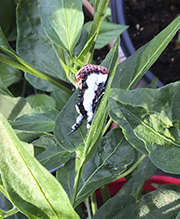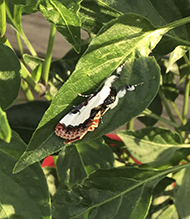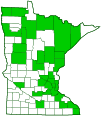pearly wood-nymph
(Eudryas unio)
Conservation • Description • Habitat • Ecology • Distribution • Taxonomy
|
||||||||
| Hodges # | 9299 |
|||||||
Conservation Status |
||||||||
| IUCN Red List | not listed |
|||||||
| NatureServe | NNR - Unranked SNR - Unranked |
|||||||
| Minnesota | not listed |
|||||||
Description |
||
Pearly wood-nymph is a common, medium-sized, owlet moth. It occurs in the United States and southern Canada east of the great Plains and in southern Mexico. There is also an isolated population in Utah and another in California. It is common in Minnesota. Adults are found from late May to August in woodlands, at forest edges, in marshes, and on the shorelines of ponds and lakes. They do not visit flowers because they (probably) do not feed. The larvae feed on evening primrose, primrose-willow, loosestrife, swamp loosestrife, and willow-herb. They have been reported to feed on grape and hibiscus, but this needs to be verified. Adults are 13⁄16″ (21 mm) in length and have a 1″ to 1⅜″ (26 to 35 mm) wingspan. The average forewing length is ½″ (13.3 mm). The forewing is boldly marked and is thought to resemble a bird dropping. The middle of the forewing is white. The kidney shaped spot (reniform spot) in the lower median area is olive-green, thin, and well defined. There is a deep, reddish-brown band on the leading edge (costal margin) from the base of the wing to beyond the reniform spot. The circular spot (orbicular spot) in the upper median area is reddish-brown and blends into the band on the costal margin. The postmedial (PM) line is olive-green and is accented with dark reddish-brown on the inner side. It is irregularly wavy, not smooth. There is a dark gray rectangular patch on the inner margin that is flecked with bluish-white scales. The area between the PM line and the outer margin forms an almost uniformly reddish-brown band, usually with some dark gray markings toward the inside. The hindwing is orangish-yellow with a reddish-brown band on the outer margin that extends from the costal margin to the inner margin. On the third segment (femur) of the front and middle legs there is a showy tuft of white and black, hair-like scales. The front legs are long and are held splayed outward when at rest. The mature caterpillar is up to 1 9⁄16″ (4 cm) long. The head is orange with black spots. The prothoracic shield is white and black. Each abdominal segment is white with up to eight narrow black bands. On the rear quarter of each segment there is a bright orange band with small black spots. The orange bands are complete on all abdominal segments. |
||
Size |
||
Total length: 13⁄16″ (21 mm) Wingspan: 1″ to 1⅜″ (26 to 35 mm) Forewing length (average): ½″ (13.3 mm) |
||
Similar Species |
||
Habitat |
||
Woodlands, forest edges, marshes, and shorelines of ponds and lakes |
||
Ecology |
||
Season |
||
One generation per year: |
||
Behavior |
||
Adults are active at night and will come to lights. |
||
Life Cycle |
||
|
||
Larva Hosts |
||
Evening primrose, primrose-willow, loosestrife, swamp loosestrife, and willow-herb, and possibly grape and hibiscus. |
||
Adult Food |
||
Adults probably do not feed |
||
Distribution |
||||
|
Sources |
|||
| 7/6/2023 | ||||
Occurrence |
||||
Common |
||||
Taxonomy |
|||
Order |
Lepidoptera (Butterflies and Moths) | ||
Superfamily |
Noctuoidea (Owlet Moths and Allies) | ||
Family |
Noctuidae (cutworm moths and allies) | ||
Subfamily |
Agaristinae (forester moths) | ||
Genus |
Eudryas | ||
Synonyms |
|||
Euthisanotia unio |
|||
Common Names |
|||
pearly wood-nymph pearly wood-nymph moth (adult) |
|||
Glossary
Costal margin
The leading edge of the forewing of insects.
Femur
On insects and arachnids, the third, largest, most robust segment of the leg, coming immediately before the tibia. On humans, the thigh bone.
Orbicular spot
A circular spot or outline in the upper median area near the antemedial line on the forewing of many moths.
Reniform spot
A kidney-shaped spot or outline in the lower median area near the PM line on the forewing of many moths.
Visitor Photos |
|||||
Share your photo of this insect. |
|||||
| This button not working for you? Simply email us at info@MinnesotaSeasons.com. Attach one or more photos and, if you like, a caption. |
|||||
Whitey Com |
|||||
On a serrano pepper plant leaf in Excelsior, MN on 7/1/23 |
|||||
 |
 |
||||
MinnesotaSeasons.com Photos |
|||||
|
|||||

Slideshows |
||

Visitor Videos |
|||
Share your video of this insect. |
|||
| This button not working for you? Simply email us at info@MinnesotaSeasons.com. Attach a video, a YouTube link, or a cloud storage link. |
|||
Other Videos |
|||
| Pearly Wood Nymph (Eudryas unio) Outside in Georgia |
|||
About
Jun 7, 2019 |
|||

Created: 7/6/2023
Last Updated:


